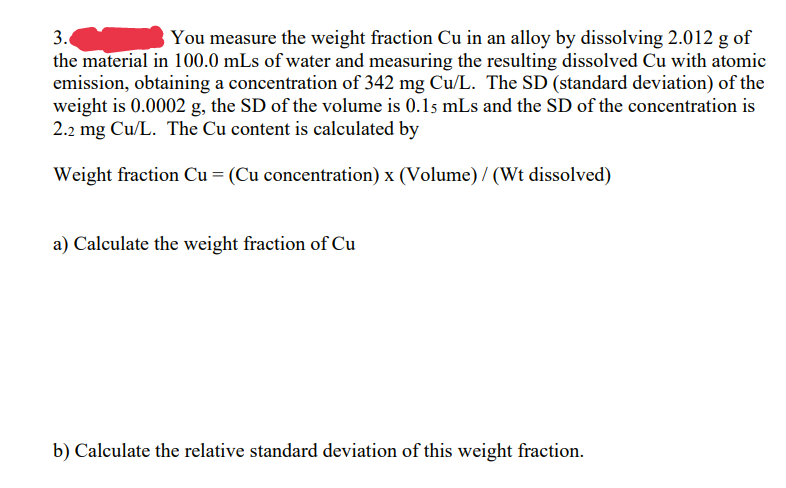3. You measure the weight fraction Cu in an alloy by dissolving 2.012 g of the material in 100.0 mLs of water and measuring the resulting dissolved Cu with atomic emission, obtaining a concentration of 342 mg Cu/L. The SD (standard deviation) of the weight is 0.0002 g, the SD of the volume is 0.15 mLs and the SD of the concentration is 2.2 mg Cu/L. The Cu content is calculated by Weight fraction Cu = (Cu concentration) x (Volume) / (Wt dissolved) a) Calculate the weight fraction of Cu b) Calculate the relative standard deviation of this weight fraction.
3. You measure the weight fraction Cu in an alloy by dissolving 2.012 g of the material in 100.0 mLs of water and measuring the resulting dissolved Cu with atomic emission, obtaining a concentration of 342 mg Cu/L. The SD (standard deviation) of the weight is 0.0002 g, the SD of the volume is 0.15 mLs and the SD of the concentration is 2.2 mg Cu/L. The Cu content is calculated by Weight fraction Cu = (Cu concentration) x (Volume) / (Wt dissolved) a) Calculate the weight fraction of Cu b) Calculate the relative standard deviation of this weight fraction.
Principles of Instrumental Analysis
7th Edition
ISBN:9781305577213
Author:Douglas A. Skoog, F. James Holler, Stanley R. Crouch
Publisher:Douglas A. Skoog, F. James Holler, Stanley R. Crouch
ChapterA1: Evaluation Of Analytical Data
Section: Chapter Questions
Problem A1.1QAP
Related questions
Question
asap

Transcribed Image Text:3.
You measure the weight fraction Cu in an alloy by dissolving 2.012 g of
the material in 100.0 mLs of water and measuring the resulting dissolved Cu with atomic
emission, obtaining a concentration of 342 mg Cu/L. The SD (standard deviation) of the
weight is 0.0002 g, the SD of the volume is 0.15 mLs and the SD of the concentration is
2.2 mg Cu/L. The Cu content is calculated by
Weight fraction Cu = (Cu concentration) x (Volume) / (Wt dissolved)
a) Calculate the weight fraction of Cu
b) Calculate the relative standard deviation of this weight fraction.
Expert Solution
This question has been solved!
Explore an expertly crafted, step-by-step solution for a thorough understanding of key concepts.
This is a popular solution!
Trending now
This is a popular solution!
Step by step
Solved in 3 steps

Knowledge Booster
Learn more about
Need a deep-dive on the concept behind this application? Look no further. Learn more about this topic, chemistry and related others by exploring similar questions and additional content below.Recommended textbooks for you

Principles of Instrumental Analysis
Chemistry
ISBN:
9781305577213
Author:
Douglas A. Skoog, F. James Holler, Stanley R. Crouch
Publisher:
Cengage Learning



Principles of Instrumental Analysis
Chemistry
ISBN:
9781305577213
Author:
Douglas A. Skoog, F. James Holler, Stanley R. Crouch
Publisher:
Cengage Learning

